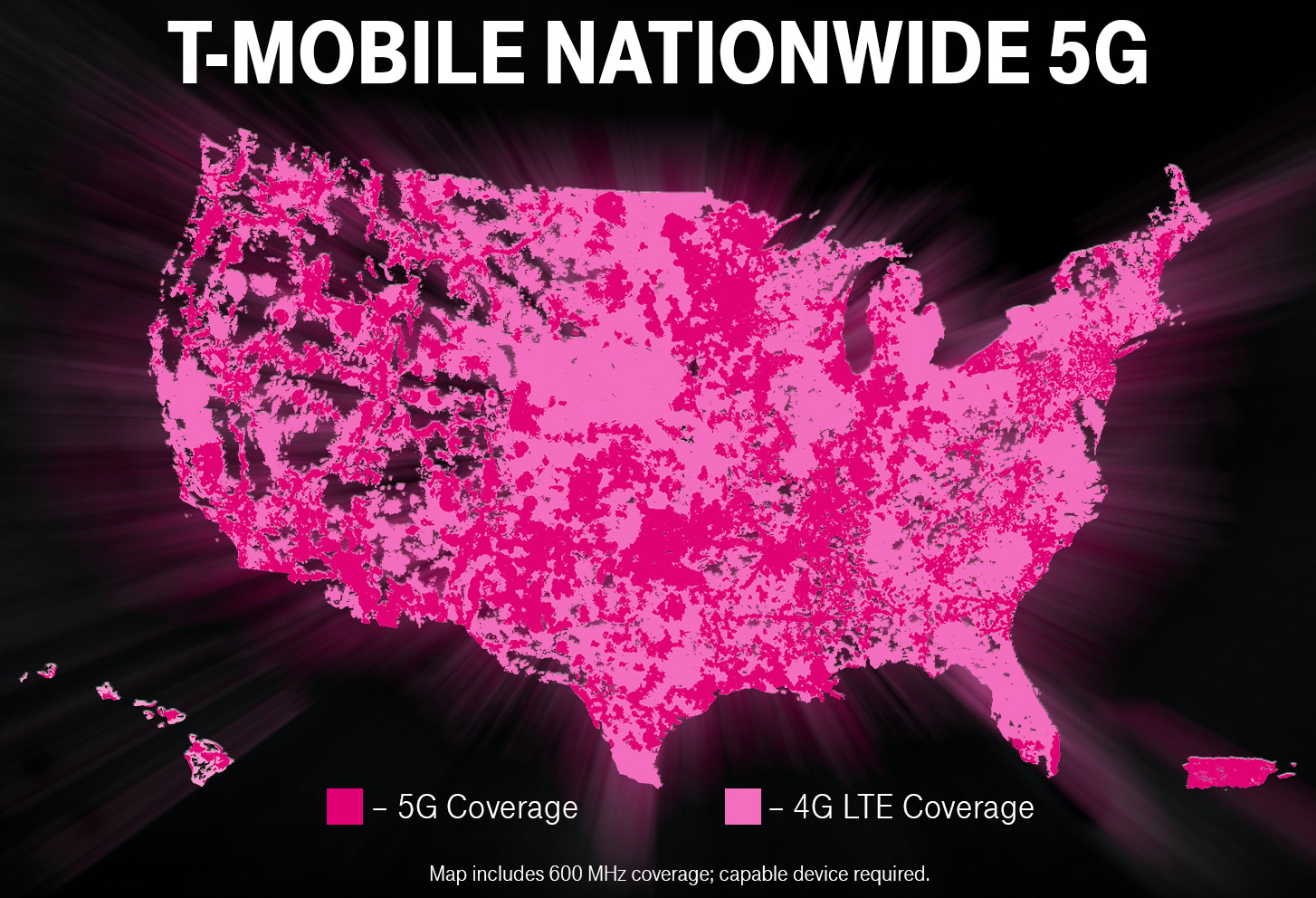T-Mobile today announced that it has launched "America's first nationwide 5G network," but T-Mobile's definition of "nationwide" doesn't include about 40% of the US population.
"America gets its first nationwide 5G network today, covering more than 200 million people and more than 1 million square miles," T-Mobile's announcement said.
The US Census Bureau estimates the population to be more than 330 million people. T-Mobile hasn't actually forgotten about the other 130 million people in the US, as a sentence halfway through the carrier's press release notes that "T-Mobile's network covers more than 60 percent of the population." At 1 million square miles, the carrier's 5G network also covers about 28% of the country's 3.53 million square miles, and it's far short of the geographical reach already provided by T-Mobile's 4G network.
We asked T-Mobile to explain why it defines "nationwide" as "60 percent of the population." T-Mobile did not answer that question.
T-Mobile's 4G LTE network covers more than 325 million people.
US coverage map is mostly 4G
T-Mobile said its 5G network today reaches "more than 5,000 cities and towns all across the country," and the company published a list of those places. There are 19,495 incorporated places in the US. Despite its actual coverage, T-Mobile's announcement uses the word "nationwide" to describe the current reach of its 5G network a dozen times while admitting that "coverage [is] not available in some areas." In the coverage map provided by T-Mobile, which is at the top of this article, you can see that the 5G areas displayed in a darker shade of pink don't include huge portions of the country covered by T-Mobile 4G. Alaska is excluded entirely. T-Mobile CEO John Legere today posted a tweet announcing the "first nationwide 5G" network and a video in which he says that "nationwide 5G is live." But Legere did not specify in the tweet or video that the nationwide 5G excludes 40% of the US population.☝️First *NATIONWIDE* 5G ‼️‼️‼️‼️☝️ That's the @TMobile way 🙌 #Nationwide5G — John Legere (@JohnLegere) December 2, 2019The 5G service T-Mobile announced today isn't much faster than T-Mobile's 4G service. That's because the "nationwide" 5G covering 60% of the population uses the same 600MHz spectrum that T-Mobile already uses for 4G. The big speed increases on 5G are expected to come from millimeter-wave spectrum, but those higher frequencies don't travel as far and are being used primarily in densely populated urban areas. AT&T acknowledged last month that its 5G service on low-band spectrum offers only 4G-like speeds this year, with actual speed increases coming next year. Verizon has said that 5G on low-band spectrum will be more like "good 4G," and T-Mobile said in April that millimeter-wave 5G "will never materially scale beyond small pockets of 5G hotspots in dense urban environments." Update at 3:28pm ET: T-Mobile sent us another reply after this article published, saying that "'nationwide' for wireless networks is defined by the National Advertising Division as covering 200 million people." We were able to confirm this in a November 2014 National Advertising Division (NAD) statement that "In general, a wireless network can claim to be nationwide or coast to coast if the provider offers service in diverse regions of the country and the network covers at least 200 million people." The NAD's 2014 statement said it came up with this standard 10 years previously, or in 2004—when the US population was 293.7 million instead of the current 330 million. Since the standard apparently hasn't been updated to reflect today's higher population, it's now much easier for carriers to claim they are nationwide without violating the National Advertising Division standard. The NAD is the ad industry's self-regulatory body.
Speeds to rise 20% on average
T-Mobile's press release today doesn't say what speeds customers will get from 5G on 600MHz spectrum. We asked T-Mobile what the 5G-over-600MHz network's current speeds are, and the carrier gave us this answer:In some places, 600MHz 5G will be a lot faster than LTE. In others, customers won't see as much difference. On average, customers with a 600MHz 5G phone should see a 20 percent download speed boost on top of what T-Mobile's LTE network delivers, and they can expect that to get exponentially faster over time, just like we saw when 4G was first introduced.T-Mobile's average 4G download speeds were 24.3Mbps, according to OpenSignal research published in July 2019. A 20% increase would bump the average speed to 29.2Mbps. Smartphones and other devices must be compatible with 5G over 600MHz in order to use the new T-Mobile service. T-Mobile is taking pre-orders for two phones that will work on the 5G network, namely the OnePlus 7T Pro 5G McLaren and the Samsung Galaxy Note10+ 5G. T-Mobile apparently had a slightly more inclusive definition of "nationwide" when it launched 4G. A 2012 announcement said that T-Mobile's "nationwide HSPA+ network has expanded to deliver a competitive 4G experience to well over 220 million people in 229 markets." The US population was 313.9 million in 2012, so T-Mobile was covering more than 70% of US residents with 4G at the time. One bit of good news for customers is that T-Mobile said that "5G access costs the same as LTE at T-Mobile," while Verizon charges an extra $10 a month for 5G on two of its data plans and AT&T only provides 5G on its most expensive plans. T-Mobile's announcement today was part of a public-relations campaign that aims to build support for its acquisition of Sprint. While the merger was approved by the federal government, state attorneys general have sued to stop the deal. T-Mobile, which has convinced some of those states to drop the lawsuit, said today that the merger will "supercharge 5G, with a broad and deep network for all Americans." T-Mobile didn't say whether it is using the commonly accepted definition for the word "all." But we presume T-Mobile considers the word "all" to include more than 60% of Americans.


